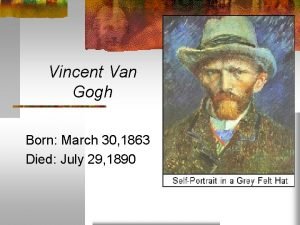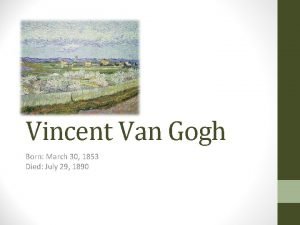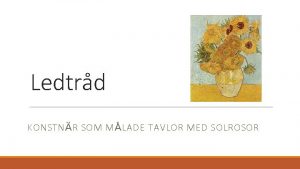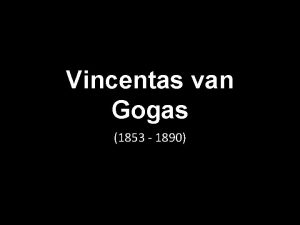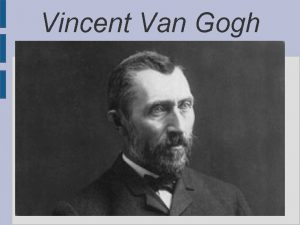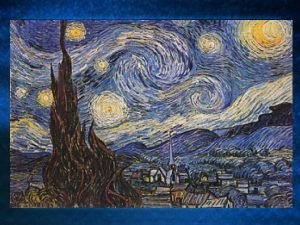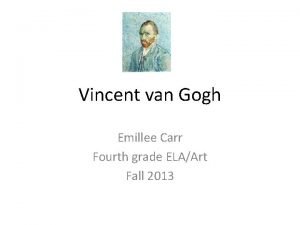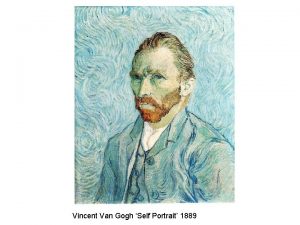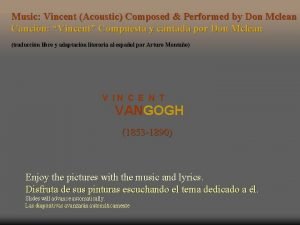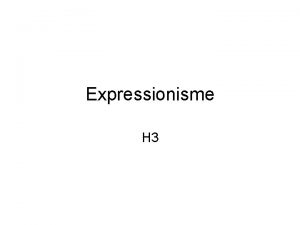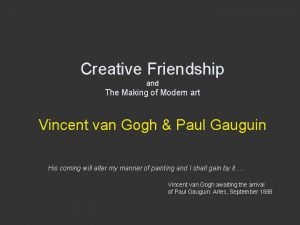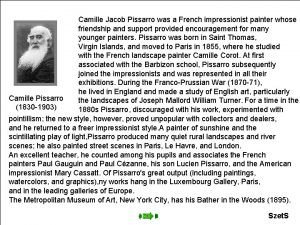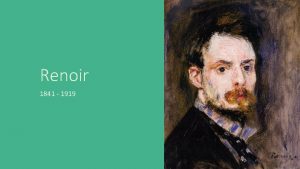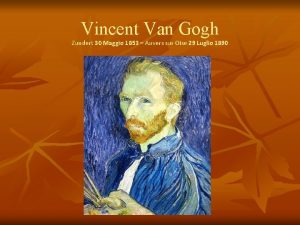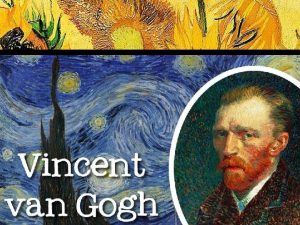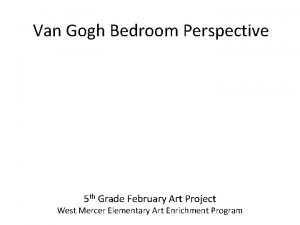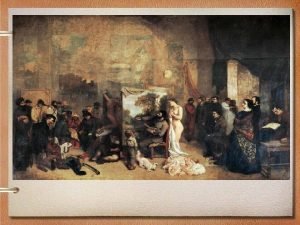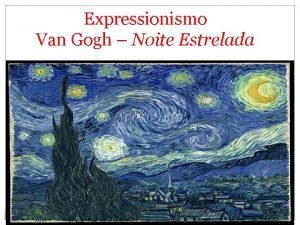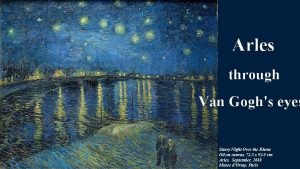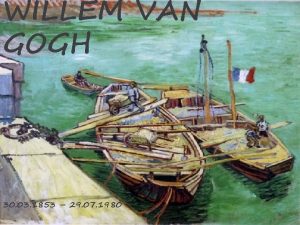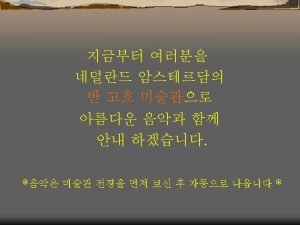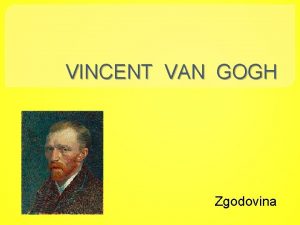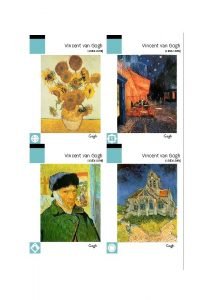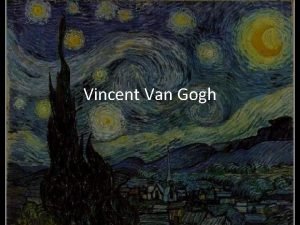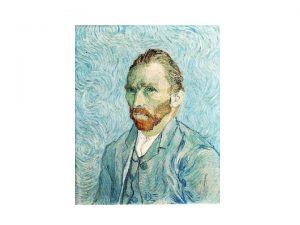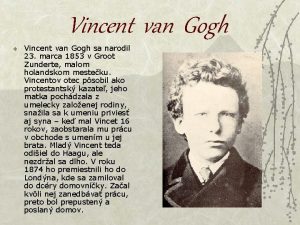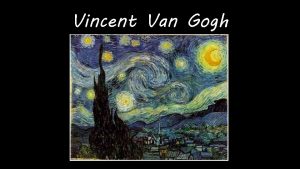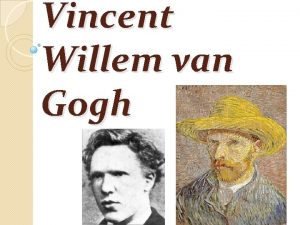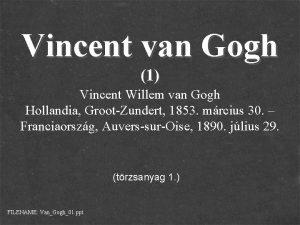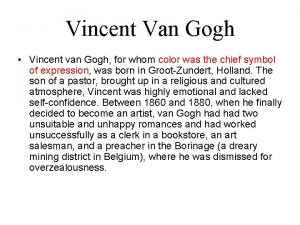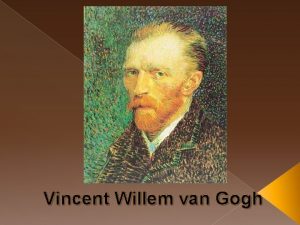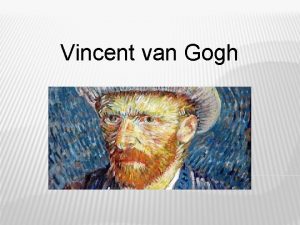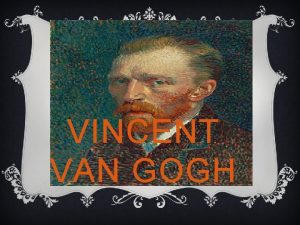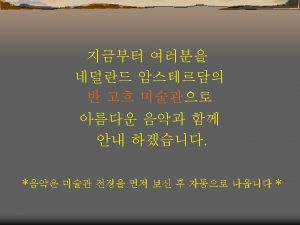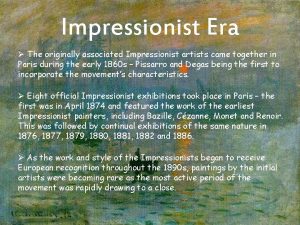Vincent Van Gogh Impressionist Artist Vincent Van Gogh

































- Slides: 33

Vincent Van Gogh Impressionist Artist


Vincent Van Gogh • 1853 -1890, Dutch (Netherlands) • Impressionist painter- meaning paintings include visible brush strokes, emphasis on light, ordinary subject matter, the impression of movement and unusual visual angles.

Vincent Van Gogh • He suffered from anxiety and mental illness most of his life, most likely schizophrenia. • Died by committing suicide at age 37, his artwork still unknown to the world.

Vincent Van Gogh • His work grew in fame after his death. • Today he is regarded as one of history’s greatest painters and an important contributor to modern art. • He produced more than 2, 000 artworks in his life, 900 of them paintings.

Vincent Van Gogh • Many of his pieces, self portraits, landscapes, and sunflowers are highly recognizable and very expensive today. • He originally wanted to become a priest and began to paint while working as a missionary. He failed his theology exams and thus decided to become an artist. His first work was titled “The Potato Eaters. ”

Vincent Van Gogh

Vincent Van Gogh • At the time he used somber colors, nothing like the vivid style that he embraced in his later work. • He then moved to Paris were he met the French Impressionists. His work grew brighter in color and he developed his unique style there.

Theo Van Gogh

Vincent’s Brother • The primary source for understanding Van Gogh comes from his letters to his brother Theo. • Theo provided his brother with emotional and financial support and bought the only painting he sold in his lifetime.

Vincent Van Gogh • Van Gogh’s theories on art and life are recorded in the letters passed between the 2 of them. More than 600 letters survive between them. • Van Gogh’s sister in law (Theo’s wife) saved their letters but was worried to release them to the public because she didn’t want the drama of Vincent’s mental illness to overshadow his artwork. • The letters were first published in 1914. • (Johanna “Jo” Van Gogh)

Vincent, Age 13 on left

Vincent Van Gogh • Siblings: Theo and Cor – brothers. Elisabeth, Anna and Willhemina (Wil)sisters. • Parents: Anna and Theodore. • Had a famous uncle also named Vincent Van Gogh who was a sculptor. Art ran in the family, 3 other uncles were art dealers.

Vincent Van Gogh • Vincent went to Catholic school for some time, and was a serious and thoughtful student. • He was later shipped off to a boarding school with his sister Anna where a successful artist/teacher showed him how to draw.

The Mission House, where he decided to become an artist

A portrait drawn by fellow French artist Henri de Toulouse Lautrec

Toulouse Lautrec

“Bedroom in Arles” The 1 st of his brighter works created in Paris

“The Night Café”

“Sunflowers”, painted in Arles, France.

The Café Terrace

Vincent Van Gogh • During his time in France, Van Gogh begins a relationship with a woman named Clasina. • She has a young daughter and is believed to be pregnant when they meet. • She gives birth to a son they name Willem. She always claims that Van Gogh is his father but the timing of his birth makes this unlikely.

A portrait by his friend and fellow artist, Paul Gauguin

Gauguin

Vincent Van Gogh • Although Van Gogh and Gauguin were friends they quarreled fiercely about art. • In 1888, frustrated and ill Van Gogh confronted Gauguin with a razor blade. • In panic Van Gogh fled his home and ran to find Clasina.

Vincent Van Gogh • He did not injure Gauguin, but the famous story occurred where he cut off his own ear, and handed to Clasina. • Gauguin left Arles and never spoke to Van Gogh again. Van Gogh was hospitalized in a critical state for several days.


Vincent Van Gogh • It is speculated that Van Gogh chopped the ear off to silence the voices in his head, due to his schizophrenia. • 1889, he is committed to a hospital. It is here he creates his most famous painting, Starry Night.

Vincent Van Gogh

“At Eternity’s Gate”, one of his last paintings

Vincent Van Gogh • At age 37, he walked out of the hospital into a field and shot himself. • He survived the immediate impact, went back inside and was pronounced dead 2 days later. • Theo fell ill, and died 6 months after Vincent. They are buried next to one another.


Vincent Van Gogh • In his final letter to Theo, Vincent stated that although he had no children he viewed his paintings as his legacy. • They indeed had an important impact on later generations of artists. • “Real painters do not paint things as they are … but as they themselves feel them to be. ”
 Vincent van gogh lebenslauf
Vincent van gogh lebenslauf Vincent van gogh born and died
Vincent van gogh born and died When was vincent van gogh born
When was vincent van gogh born Vincent van gogh solrosor
Vincent van gogh solrosor Vincent don mc
Vincent don mc Postimpresionistas
Postimpresionistas Vincent willem van gogh
Vincent willem van gogh Impressionalism
Impressionalism Emil lee
Emil lee Vincent van gogh champ de blé aux corbeaux
Vincent van gogh champ de blé aux corbeaux Starry night over the rhone pronunciation
Starry night over the rhone pronunciation Noche estrellada descripción
Noche estrellada descripción Self portrait with monkey 1940
Self portrait with monkey 1940 Postimpressionist artist. *
Postimpressionist artist. * Van gogh pronunciation
Van gogh pronunciation Don mclean vincent (ost van gogh)
Don mclean vincent (ost van gogh) Vincent van gogh expressionisme
Vincent van gogh expressionisme Vincent willem van gogh
Vincent willem van gogh Van gogh and gauguin friendship
Van gogh and gauguin friendship Impressionist self portrait
Impressionist self portrait Impressionist music period
Impressionist music period Camille french painter
Camille french painter Impressionist 1841-1919
Impressionist 1841-1919 What came after post impressionism
What came after post impressionism Zundert casa van gogh
Zundert casa van gogh Portræt af dr. gachet
Portræt af dr. gachet Van gogh slikar
Van gogh slikar Van gogh bedroom perspective
Van gogh bedroom perspective Quando e dove nasce l'impressionismo
Quando e dove nasce l'impressionismo Noite estrelada em movimento
Noite estrelada em movimento Cor monocromia
Cor monocromia Van gogh colour theory
Van gogh colour theory Silent night van gogh
Silent night van gogh Van gogh kunststil
Van gogh kunststil

